The Language of the Lords
donti se sha madbi

| DATE | November 2021 - April 2025 |
| INSPIRATION | Maya glyphs |
| RELATED |
In autumn of 2021 I'd been reading a book on how to read Maya glyphs (specifically Reading the Maya Glyphs by Michael D. Coe and Mark Van Stone; incredibly detailed book and super interesting, highly recommended if you're at all interested in Maya culture) and, like almost any fun script, it immediately set my brain churning on how I could do something similar. Spire and I had been working on a worldbuilding project featuring demons and angels and I thought it would be a great backdrop for some funky little lizard heads.
The sprawling city-fortress of Castle is ruled by demonic Lords, divided into ever-bickering Houses. Angels are an enslaved caste who must serve and fight for their lords. If there was a time before the Lords' reign over Castle, no one alive remembers it.
Phonology
| LETTER | SOUND | LETTER | SOUND | LETTER | SOUND | ||
| p | p | b | b | a | a | ||
| d | d | t | t | e | ɛ | ||
| f | f | g | g | i | i/ɪ | ||
| k | k | h | h | o | ɔ | ||
| s | s | sh | ʃ | u | ʉ | ||
| m | m | n | n | ||||
| l | l | r | ɽ |
Nouns
The Language of the Lords has a limited number of syllables and features many homonyms. A single word can belong to as many as 15 categories of nouns, each of which has its own suffix.
| people | locations | animals | plants | abstract | tools | creations | children |
| -ke | -ne | -me | -be | -ti | -ni | -di | -she |
| angels | materials | wearables | food | body | mental | court | |
| -si | -shi | -mi | -de | -ki | -ge | -bi |
These suffixes can be ommitted under certain circumstances:
- The conversation is informal.
- The context is clear*.
However, the suffix is always included in spoken language when:
- The conversation is formal.
- A written text is being read aloud.
- The nouns is in the people, angel, or court category.
- The listener is an angel.
This means that a sentence like "did you break your ankle?" would be gali ket keti hag? when the listener is a demon and gali ketis ketish hagsi? when the listener is an angel (with the diminutives -is and -sh added to the pronoun and possessive). The words for angel body parts and demon body parts are the same word belonging to different categories but the demon body part does not need to be clarified. However, simply using hag on its own when referring to an angel's ankle would humanise the angel, which is considered crass, and therefore the category must be specified so the listener knows the speaker is talking about an angel ankle.
This is the same reason that the people and court categories are always clarified. It would be absolutely terrible if a speaker referred to an imp (dit, people category) as just a dit and not a ditke. Otherwise it could be confused with ditsi, "cherub", angel category, or ditshi, "sand", materials category. Nouns in the people and court categories are more important than other categories and there must never be any room for confusion.
This elaborate system of homonyms does allow for wordplay and tongue twisters, such as this popular nursery rhyme:
- ditke ditsi dadna ditshi nakna ditni dot'kan dag'ka
- English: An imp and a cherub drank sand from a glass and choked.
- Transliteration: imp.people cherub.angel both sand.material from glass.tool drink.past.then choke.past
- (Dot'kan and dag'ka should here actually be conjugated as detdukan and deguka but the way it is written in this rhyme is considered the child-conjugation, a simple form of conjugation that is allowed in song-writing. An even more informal way of saying the same sentence would be ditke ditsi dit' nakna dit' dot' dag'ka, dropping any unncessary categories and the word "and", and only child-conjugating the final verb.)
Articles
|
|
Demonstratives
|
|
Adjectives
Any noun can be turned into an adjective by adding the suffix -t and preceding the thing being described.
- gilbet ganbe, "mint leaf"
- senit sedshe, "bookshelf"
- shaknet fidne, "sunroom"
While word with the -t suffix must always have its category clarified, the category is often not clarified for the final noun in casual conversation if the meaning is clear.
- gilbet gan, "mint leaf" (though could also be "mint-paint")
- senit sed, "bookshelf" (though could also be "book-waist")
- shaknet fid, "sunroom" (though could also be "sun-cat" or "sun-territory")
A stronger way to form associations between words is to use se, which translates to "of". The best example of this is in the name of the language, donti se sha mabdi, "Language of the Lords". While one could techincally say mabdit donti, "lord-language", this construction diminishes the importance of the relationship between the two words. Senit sed could be any old bookshelf, but sedshe se fin seni ("shelf of books") feels like it is referring to a specific shelf.
Adjectives can become negatives with the suffix -ik; eg. legtit, "loyal", can become legtitik, "unloyal". In casual speech, the -t can be entirely replaced by -k to form the negative; eg. legtik, "unloyal".
Adjectives can become comparatives with the suffixes -at and -(t)ota.
- legtit, "loyal"
- legtitat, "more loyal"
- legtitota, "less loyal"
Superlatives are formed with the word pul, "mountain", in front of the comparative.
- legtit, "loyal"
- pul legtitat, "most loyal"
- pul legtitota, "least loyal"
Colours
There are no individual words for colours. Instead, adjectives are used alongside the word dab(mi), "colour".
| ENGLISH | LORD | TRANSLATION |
| dark red | batkit dab | "body/flesh colour" |
| light red | penkit dab | "blood colour" |
| orange | shaknet dab | "sun colour" |
| yellow | badkit dab | "eye colour" [in demon form] |
| green | gabnet dab | "leaf colour" |
| blue | kigbet dab | "cornflower colour" |
| purple | bamet dab | "fish colour" |
| pink | senshet dab | "veal colour" |
| brown | legmet dab | "dog colour" |
| black | pulnet dab | "mountain colour" |
| dark grey | dodnit dab | "rain colour" |
| light grey | fenmet dab | "bird colour" |
| white | nosit dab | "[angel] bone colour" |
| gold | lashit dab | "gold colour" |
| silver | lakshit dab | "silver colour" |
| dull gold/silver | latshit dab | "fur [material] colour" |
Numbers
Each of the 10 digits has its own consonant, with the vowel changing every group of ten. This means numbers with multiple digits can be read in either direction.
| 0 | 1 | 2 | 3 | 4 | 5 | 6 | 7 | 8 | 9 |
| ibi | isi | idi | iti | ifi | iki | ishi | imi | ini | igi |
| 10 | asa |
| 100 | oso |
| 1,000 | usu |
| 10,000 | asu |
| 100,000 | ose |
| 1,000,000 | usa |
- 48: afa ini
- 3629: utu osho ada igi
- 1/2: isi se idi
- 8/37: ini se ata imi
Personal Pronouns
All demons are "he" and are considered "male", regardless of sex or gender presentation*. This is not a gender neutral pronoun and is very distinctly masculine; the Language does have "she" and "they", but these are reserved for angels. It would be unthinkable for a demon to be be referred to by any pronoun other than "he". It is common for high-ranking Lords to refer to themself in the 3rd person. This distinction between "he" and "she" stems from the similarity between shen ("she") and sen ("angel"). At some point, the similarities between these unrelated words caused enough concern that demons stopped using shen entirely.
Most demons consider angels to be "she" by default, but this assumption comes from demons being unknowledgeable about angel culture rather than from beliefs about gender. A demon will almost always refer to an angel he doesn't know as "she".
When a demon speaks directly to an angel, the 2nd person pronoun ket is given the suffix -is to mark the listener as beneath the speaker. The same is done for the 2nd person possessive and reflexive with the suffix -sh. This would never be done for a demon speaking to another demon, even if the listener is far below the speaker, unless the speaker was looking for a fight to the death. The diminutive suffix does not need to be placed on 3rd person pronouns, though it technically can. Surprisingly, it would never be placed on a 1st person pronoun.
There is no distinction between the subject and object form of the personal pronoun.
|
SUBJECT/ OBJECT |
POSSESSIVE | REFLEXIVE | |
| 1st person (single) | kon | koni(t) | kona |
| 2nd person | ket(is) | keti(sh)(t) | keta(sh) |
| 3rd person (single, female) | shen | sheni(t) | shena |
| 3rd person (single, male) | desh | deshi(t) | desha |
| 3rd person (single, neutral) | nod | nodi(t) | noda |
| 1st person (plural) | minsad | mini(t) | mina |
| 3rd person (plural) | hashan | hashi(t) | hasha |
Since the possessive form is considered an adjective, one would be expected to add the -t suffix to the end, but this is usually only added when the speaker wants to emphasise the fact that something is a possession; eg. koni feshe, "my toy", vs konit feshe, "my toy, it belongs to me". This is the case more often than in English as demons are culturally protective of their possessions and will often seek to remind the listener if they own something, or to assure the listener they know that something belongs to someone else. If an object is raised as the topic of conversation, it will often continue to be referred to with a possessive adjective when an English speaker would begin to refer to it as "the [item]".
Demons may also use this possessive emphasis to establish dominance over rivals. A Lord may challenge another Lord to a duel for ownership of their sceptre and express his confidence in winning it by saying desh deshit migbi lepmusan, "I (high-ranking) will win my (high-ranking) sceptre" instead of desh ketit migbi lepmusan "I (high-ranking) will win your sceptre".
Verbs
Word order is Subject Object Verb, so objects are bracketed by the subject and verb. In a question, the verb moves to the beginning of the sentence.
There are generally two ways for verbs to conjugate in the present tense, slimming and fattening. A fat verb has either "a" or "o" in its first syllable and will "slim" as it conjugates, turning that vowel into "i", "e", or "u". A slim verb has "i", "e", or "u" in its first syllable and will "fatten" as it conjugates, turning that vowel into "a" or "o".
|
| ||||||||||||||||||||||||||||||||
- kon fen dibti or kon fende dibti, "I eat fruit
- hap hap dabto or hapme hapde dabto, "a shrew eats a grape
The infinitive is indicated with the preposition sa; eg. desh sa dibtu mabshe ganmo, "I (high-ranking) want to eat a meal".
Only the root of a verb is written in heads, even if the conjugation has different sounds. Any verb endings are written in slabs. This means that the sentence desh gut detdu would be written as DESH GUT(de) DOT(du). See the writing system for more information.
The negative is formed by adding shu in front of the verb; eg. kon fende shu dibti.
Tenses
To conjugate verbs in any tense other than the present tense, simply take the conjugated present tense and add the appropriate suffix.
| AFFIX | TENSE | SLIM VERB sa tentu, "to glow" |
FAT VERB sa shokna, "to be" |
|---|---|---|---|
| none | present | kon tenti, "I glow" | kon shokni, "I am" |
| -san | future | kon tentisan, "I will glow" | kon shoknisan, "I will be" |
| -ka | past | kon tentika, "I glowed" | kon shoknika, "I was" |
| -nat | conditional | kon tentinat, "I would glow" | kon shokninat, "I would be" |
| -shap | progressive | kon tentishap, "I am glowing" | kon shoknishap, "I am being" |
| none | imperative | tentu, "glow!" | shokna, "be!" |
The passive tense is indicated with the auxiliary sa gansu, which conjugates according to tense. The modified verb is used in the present tense regardless of the tense of the sentence.
- sa sangudka, "to study"
- desh singadoka, "he studied"
- desh genuka singado, "he was studied"
- hashan ganetnat singado, "he would be studied"
Adverbs
In the same way that adjectives are constructed using a suffix, adverbs can be created from nouns using the -s suffix. Adverbs must always have their categories clarified.
- ginmi, "heaviness"
- ginmit, "heavy"
- ginmis, "heavily"
In general adverbs precede the verb, but this is not a hard rule.
- hashan relges katnet, "they happily danced [to entertain]"
- shen sago seges, "she thought obsessively"
Conjunctions & Prepositions (section under construction)
| LISTS OF VERBS | ||
|---|---|---|
| ENGLISH | LORD | EXAMPLE |
| and | -n | desh genmun napmo*, "he paints and sings" |
* the use of the verb sa nepma instead of sa nepna implies singing for pleasure rather than for a purpose like entertaining someone else, even though they both mean "to sing"
| LISTS OF NOUNS | ||
|---|---|---|
| ENGLISH | LORD | EXAMPLE |
| and | -m on all but final noun | neknim bikbem bikme "a basket, an onion, and an ox" |
| and (emphasis between two) | dadna after second noun | bikbe bikme dadna "an onion, an ox, both" |
| but not | -d on second noun | bikbe bikmed "an onion but not an ox" |
| or | -tas on all but first noun | bikbe bikmetas neknitas "an onion or an ox or a basket" |
| nor | -tak on final noun (used alongside -d) | bikbed bikmetak "neither an onion nor an ox" |
| PHRASES/SENTENCES | ||
|---|---|---|
| ENGLISH | LORD | EXAMPLE |
| but | gush | desh genmu gush napmonik, "he paints but he doesn't sing" |
Conversation
The Language of the Lords does not have individual words for "yes" and "no". Instead, the relevant verb is repeated to answer questions, similar to Scottish Gaelic. For example, if someone asks you sedshinto ket gan?, "do you want tea?", you would either reply sedshinti, "I want", or shu sedshinti, "I don't want." Simply replying shu for "no" is also acceptable in casual conversation.
You can use the auxiliary sa gansu for general agreement or disagreement if there is no direct verb you are replying to. For example, if someone is murdering your favourite servant, you could shout shu genu!. Or maybe genu! if you are enjoying it, I guess.
Example Sentences
-
English: My family was forged in the flames of war
Language of the Lords: konit hepbi ne sha hebshi se kefbi genuka habno -
English: The little child was playing with his kitten
Language of the Lords: sak dimtit ditke ni deshit fidshe faloshapka -
English: My glorious, mighty lord shall enjoy the spoils of his victory without disturbance
Language of the Lords: koni segbit dutit kodbi sha sedshindi se deshit lapmi rashgosan nanistid
Writing System
The Language of the Lords reflects everything the ruling class holds dear: triumph, treasure, and the elite status of the demonic race. Poems and stories are shared through the oral tradition of performance and writing is usually reserved for "historical" documents, grandiose retellings of events that may or may not have gone down quite as recorded. For this reason, the demonic writing style does not lend itself well to quick note-taking or casual texts.
The demonic script is made up of glyphs featuring imagery important to demons; angel imagery is usually reserved for phonetic symbols or less important elements. The script contains several different types of glyphs: heads, slabs, flags, pillars, and banners. Each serves a different phonetic and grammatical purpose.
There is a secondary writing system known as mutket segmi, "servant scratch", or just seg, "scratch", which is a simplified version of the traditional script. Lords do not learn this version as it is purely for servants and lesser lords to retain inventory and keep relevant house-keeping records. Learn more about servant scratch here.
Use the below generator to create some demonic words, or read on to learn how to read them! The original code used for the generator can be found here.
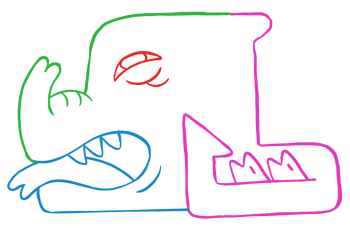
Heads
Heads are used to indicate important words like nouns and verb roots. A single head represents one syllable; words comprised of more than one syllable are made up of multiple heads in a row biting each other. The head is made up of four parts: the eye (initial consonant), nose (vowel), mouth (final consonant), and the ornamentation.



The Language of the Lords has a limited number of syllables and features many homonyms. To avoid confusion, context is given through a head's ornamentation, indicating to the reader which category that word belongs to. For example, fa could mean "rib", "spruce", or "nail"; by using the body, plant or tool ornamentation respectively, the intended meaning is clear. While the category of word is often omitted in spoken conversation, it is always included in writing. If a word is made up of multiple heads, the ornamentation is placed on the final head.
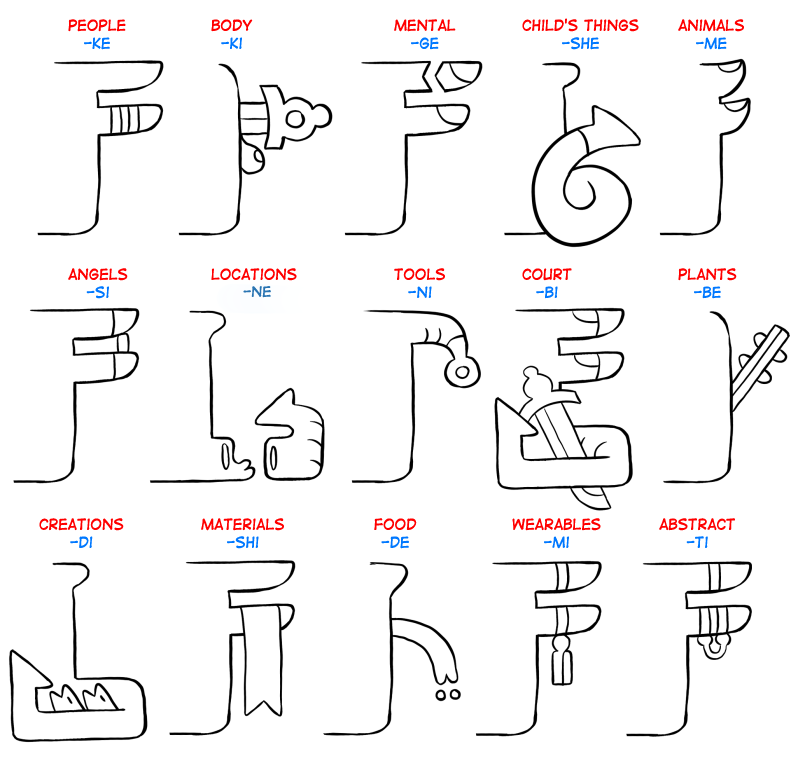
Slabs
Slabs are used to indicate pronouns and are logographic rather than phonetic. Clarification on the pronoun's form (ie. subject vs reflexive) are indicated using flags.
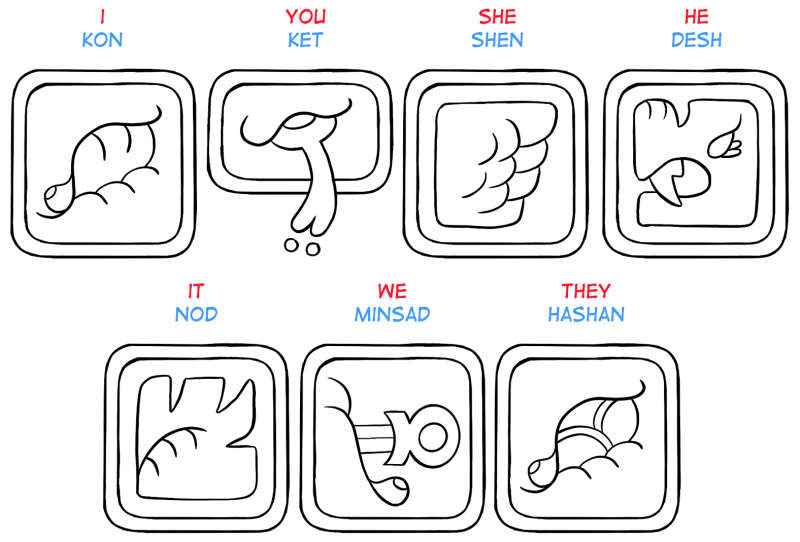
The desh slab ("he", but also used as a formal, superior "I") has a standard form but it is common for desh slabs referring to high-ranking Lords to be more representative of that Lord's appearance. Slights can be pointed towards opposing Lords by making the figure in their desh slabs appear ugly or weak.
Flags
Flags are used to indicate additional grammatical information, similar to the hiragana that follows kanji in Japanese. These are read phonetically. Multiple flags can be combined into one or stacked with multiple flags on a single pole, but words with great importance, like those referring to Lords or the court, may make use of several large individual flags to highlight their glory.
The imagery on the flags is derived from words beginning with that letter, similar to the modern Latin alphabet.
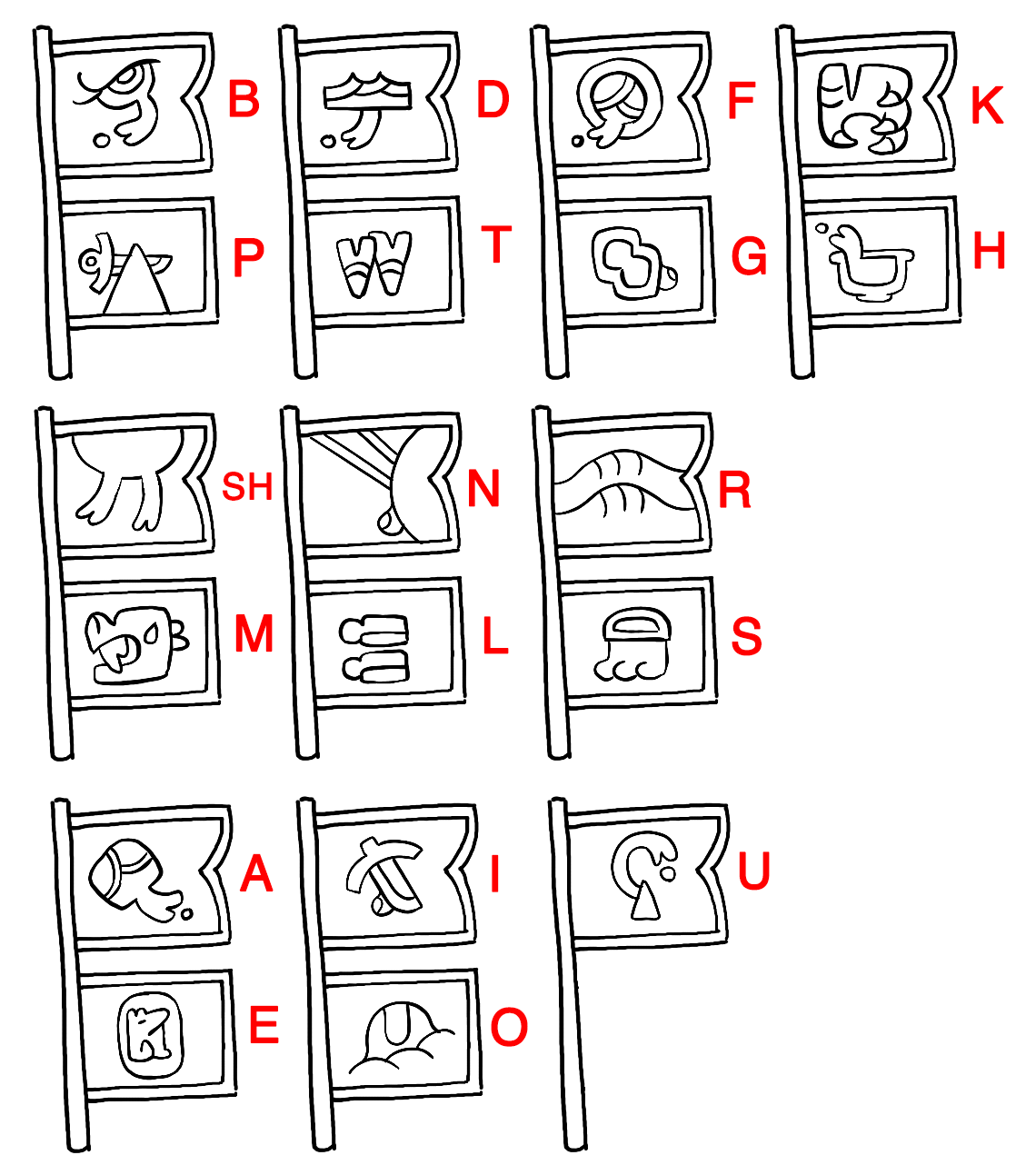
Pillars
Pillars are used to represent whole words. These are usually common words like "the" or "and". Special pillars are sometimes used to refer to angel-related topics instead of being written in full heads.
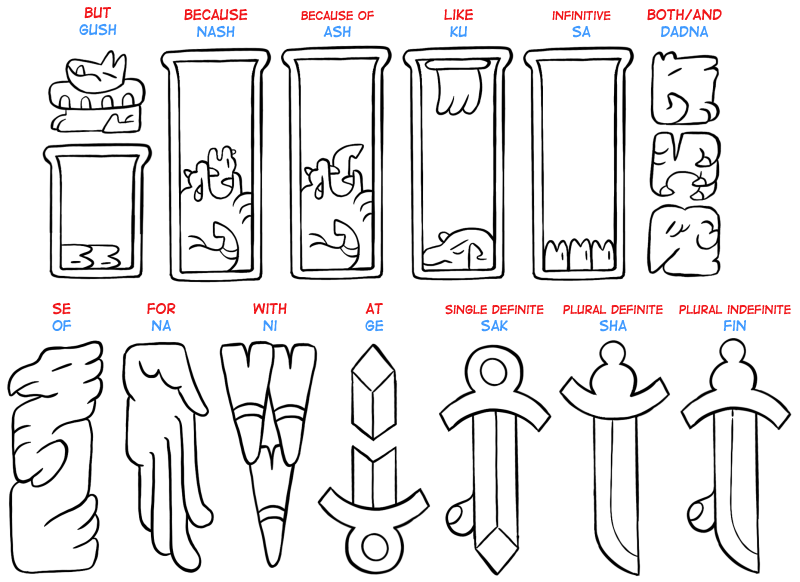
Banners
Banners are different from flags in that they introduce a subject rather than following it to provide grammatical information. Banners are purely used for important titles like "Prince" and the names of the many Houses. These court-related banners are being revised constantly as the Houses unite and break apart and special records are kept to make sure scribes are up to date. One subject may have many, many introductory banners depending on how well-off and important they are, or depending on how impressive they're trying to seem.
Although some banners feature the same imagery as some flags, it is easy to tell them apart as banners do not feature the classic flag frame or handle. Banners may be used in place of nouns or pronouns (such as writing "the [Prince title banner]" instead of "the prince" using heads) but this is generally considered poor writing and is mostly popular among younger, modern scribes.
[dec 2023: images coming soon!]
Writing Examples
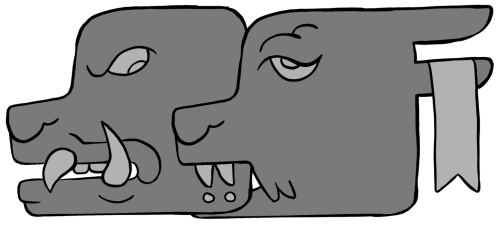 madlas(shi) "snow" |
 hebdod(be) "oily substance" |
Due to the nature of the demonic script, it is possible to render sentences as full, "readable" illustrations, as below (donti se sha madbi). This means that many Lords will commission paintings or murals of their triumphs rather than plaques or inscriptions. This leads to the problem of scribes having to choose words with facial expressions that seem more fierce or that look more similar to the Lord in question so as not to invoke his ire*.
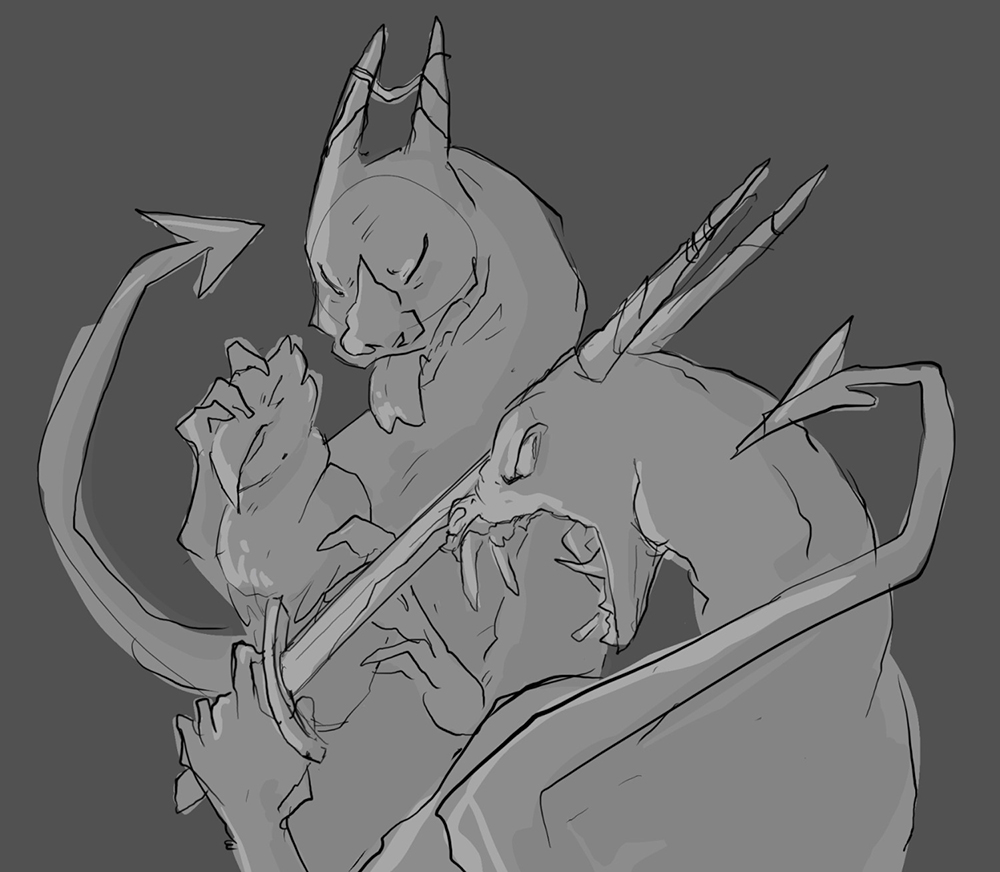
Of course, every scribe has to start somewhere... While writing isn't a skill that all lords care to practise, it is a valued skill, so many young lords of lesser houses will go through rigorous training to ensure they will be able to properly portray the great deeds of their superiors. Children's writing is especially cute.

Development
The initial concept was:
- Main words are comprised of demon heads.
- Prepositions, pronouns etc indicated with smaller glyphs.
- Heads can be one or two syllables.
- Words made up of more than two syllables are written with multiple heads connected by some following decorative element, like bone, strands of hair, fire etc.


The first pass at a general direction for the script was too chaotic; the eye would have to go all over a single head to work out what it was meant to say. I needed to simplify things. We decided to focus on four elements: the eyes, nose, mouth, and headpiece. Since there would likely be fewer cohesive nose shapes, I chose that part of the head to represent the vowel. The eye would be the initial consonant and the mouth would be the final consonant. Each head would now be a single syllable. We started to draw up some ideas.

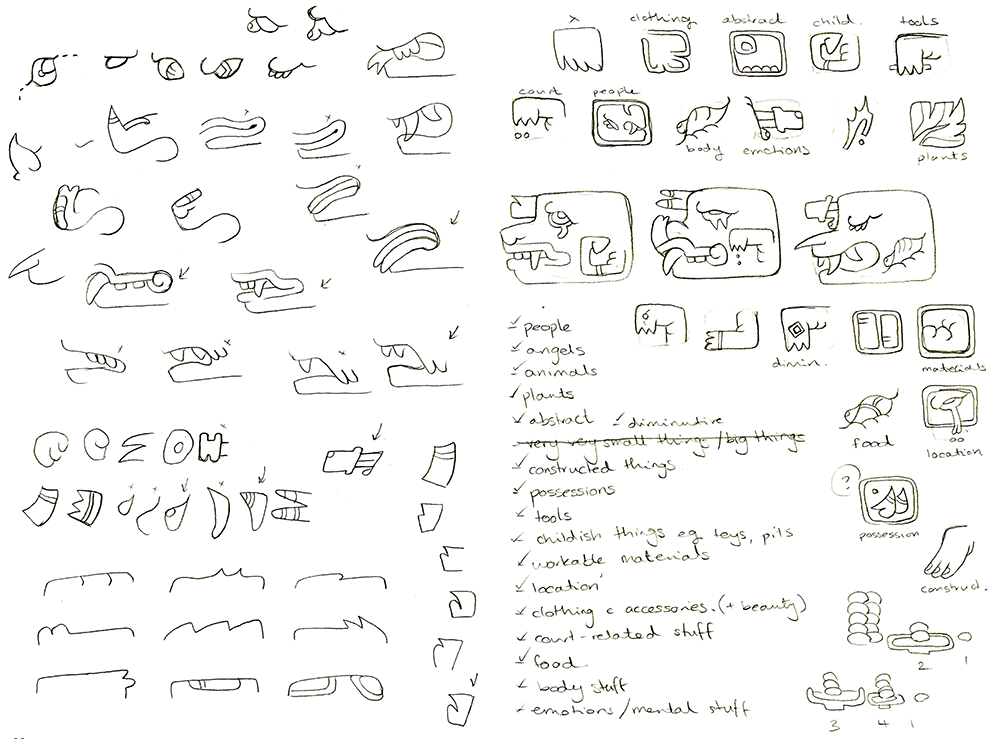
I put some of these new elements together to check out things were looking so far. The faces were looking great but the top and back of each head felt very empty without any decoration. I briefly played with the idea of some different scalps but they felt too cartoony. We definitely also needed to add something back into the cheeks like in our first versions. I decided these little decorative squares would be used as context clues for a language with limited words.
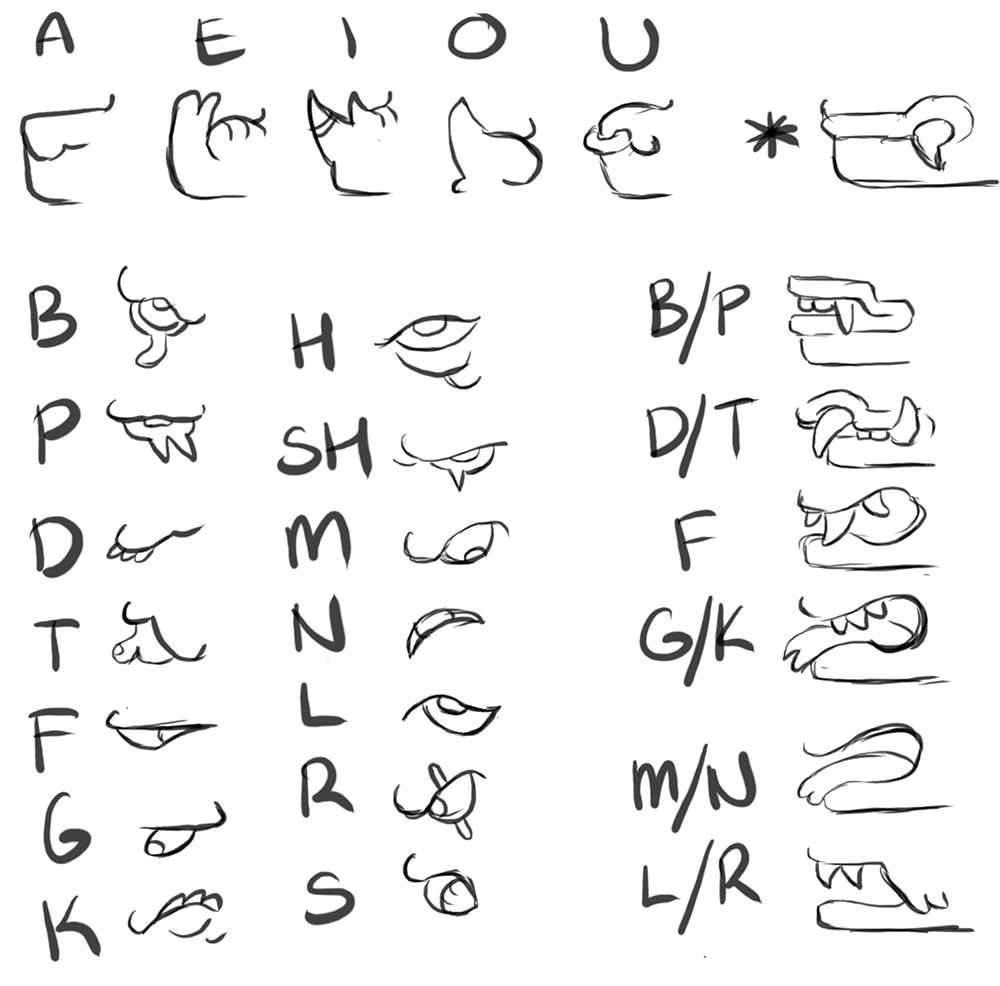

I still only wanted the most important words to be written as full heads and decided the rest of the script would be made up of a combination of phonetic glyphs and logograms. We set about drawing up some smaller glyph ideas, but came to a standstill on development.
